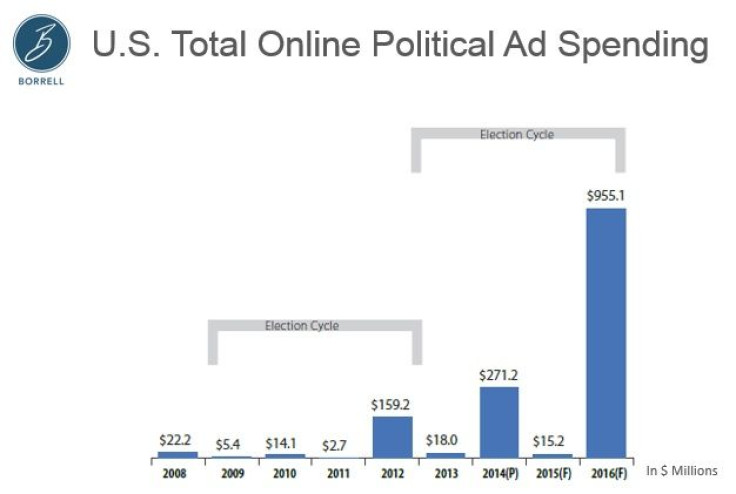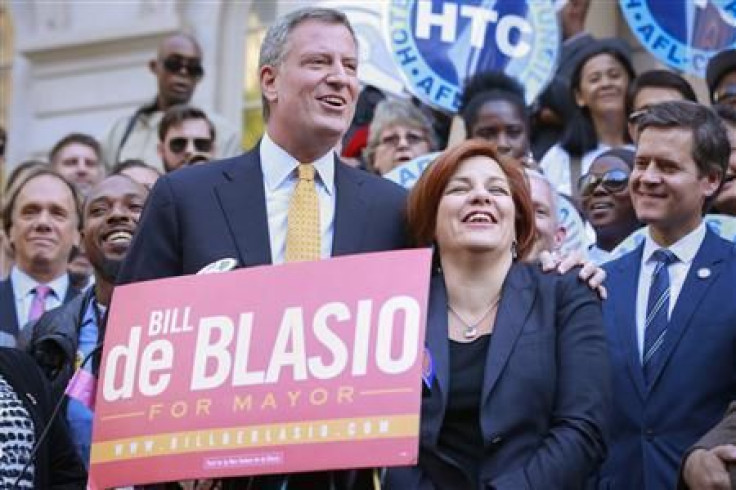Midterm Elections 2014: No TV Cable? Candidates Struggle To Court The Cord-Cutter Vote

Let’s say you dumped your cable-TV service a few years ago and never looked back. You have a Web-enabled TV and you’re perfectly content streaming shows and movies online. You even thought you were getting the added benefit of finally insulating yourself from all the negative ads that flood the state every two years.
Yet, now you’re watching “Modern Family” on Hulu and up pops a political attack ad castigating the U.S. senator running for re-election -- the same ad that seems to pop up on websites every time you browse the Internet.
At least you’re not alone. As the 2014 midterm elections heat up, candidates in states with the closest races are increasingly seeking out cable-less voters on places like Facebook, Pandora and Hulu -- much to the dismay of consumers who thought their curated media world would spare them from the cyclical barrage of election-cycle campaign ads. “Am I the only one about ready to put my fist through the monitor every time one pops up?” one DataLounge commenter said of Hulu political ads.
Last year, more than 1.7 million Americans dropped their pay-TV subscriptions, according to a study from the Leichtman Research Group. Cable giants like Comcast Corporation and Time Warner Cable are losing tens of thousands more each quarter. In a political arena that segments the population into groups like "soccer moms" and "office park dads," these are the so-called "cord cutters" -- the growing pool of voters who are reducing their exposure to broadcast television, cable, newspapers, magazines and terrestrial radio. According to a recent industry study comparing data from 2008 to the present, the average American is spending 25 fewer minutes a day with those legacy media and 27 more minutes with online and mobile media.
One way campaigns are adjusting to this shift is by purchasing ads directly from the cord-cutter favorites that are replacing traditional television and radio. In 2012, for example, Hulu saw a 700 percent increase in the number of political ads from previous election cycles. In the current election, Pandora Media Inc. is airing ads for roughly 400 campaigns, a spokesman for the online radio company told CNBC.
For campaigns, an added benefit of those kind of ads in comparison to traditional TV and radio ads is the prospect of higher “completion rates.” Because users can't fast forward through them, and because it's more cumbersome to flip stations, there's a higher expectation that the viewer will actually sit through them.
In any case, campaigns have no choice but to embrace the new platforms if they want to reach voters like Alex Musto, a 30-year-old video editor from Brooklyn.
“I’ve basically never had cable,” Musto said. “I watched broadcast TV for a while, but I stopped after they converted to digital antennas. I just watch on Hulu or Netflix.”
Big Data, Micro Targets
Between ads on streaming services and social media, online political ad spending is expected to grow 1,825 percent in 2014, according to research from Borrell Associates. To claim a larger piece of that share, tech companies are aggressively touting their ability to microtarget -- something legacy media can't do with nearly as much specificity. That's because legacy media is a one-way stream of information from news outlets to viewers, while online platforms involve a back-and-forth exchange of data.
That user data -- often embedded in Internet browser cookies -- allows campaigns to know far more about who they are sending ads to than just geographic location. Depending on the online ad platform, they can track target audiences based on location, interests, political leanings and consumer habits. If a campaign's target voter lives in Seattle, drinks Starbucks and reads Mother Jones magazine, the campaign can tailor its ads directly to that micro-demographic. This is why when browsing the Internet, you may end up seeing the same political ad at different sites. The ads are being served to you personally, based on your metadata.
In the current election, companies are making it easier for campaigns to microtarget. For example, Pandora launched a feature that allows candidates to target voters based on their specific listening habits, which the company believes may correlate with a person’s political affiliations.
Facebook Inc. has gone a step further, expanding its “Custom Audience” feature to allow campaigns to target users by linking voter files and political preferences. Politicians have long used voter files in direct-mail campaigns -- with the help of data brokers like Acxiom -- but Facebook has streamlined the process by giving campaign managers a direct link.
“There is no third party,” Josh Eboch, political director for Sen. John Cornyn of Texas, who began using Facebook’s feature last year, said. “What used to take weeks now takes hours.”
Insiders say the change was a long time coming for an advertiser segment that tends to stick to what it knows. “What you’re seeing is campaigns growing up before our very eyes,” Alex Kellner, director at Bully Pulpit Interactive, an ad company that focuses on digital platforms for political campaigns, said. “A campaign manager who was only placing TV ads 20 years ago was still missing out on things they could have been doing.”
Bully Pulpit has been around only five years, but it's already one of the oldest companies that specializes in social media and digital strategies for political campaigns. The company was founded by marketers who worked on Barack Obama’s historic presidential run in 2008, when the then-senator from Illinois famously leveraged social media to attract record numbers of under-30 voters. Bully Pulpit boasts that it has replicated that success at the state and local levels, including for Gov. Terry McAuliffe of Virginia and Mayor Bill de Blasio of New York.

Old Habits, New Data
Since cord cutters tend to be younger, it's habitually easier for politicians to ignore them. Despite Obama's overwhelming success with first-time voters, campaigns still don't expect young voters to turn out, and therefore fail to go after them. Kellner said that is finally changing with the ability to target narrower segments of the population online.
“The more sophisticated campaigns aren’t looking at it as a chicken-and-egg scenario with young people,” he said. “They’re identifying the right young people to talk to.”
But not as much as they might. Political ad spending is projected to top $8.2 billion this year, and well over half of that will go to television. All told, online advertising will account for only 3.3 percent of the total pie. Corey Elliott, Borrell’s director of research, said campaign managers are of course concerned about reaching online voters, but as in any industry, old habits die hard.
“It feels like at the very last minute, whoever’s in charge of the campaign, pulls back and shoves it all on to TV,” he said. “There’s been leaps and bounds, but TV’s still getting the major share.”
More Complex, More Opportunities
While the fragmentation of audiences across different media platforms complicates campaigns' ability to reach voters, the audience's shift online is letting underfinanced campaigns put up a fight through cheaper, niche marketing strategies that avoid expensive broadcast television altogether.
For example, the campaign in Colorado to pass a ballot measure mandating special labels for some products with genetically modified ingredients has been grossly outspent by opponents in the food industry. To spread the word about the initiative, the campaign has relied on a mix of both demographically microtargeted ads and banner ads on news sites. The former method sends an ad only to specific users based on factors like their cookie profile, while the latter appears for all users who come to a specific site.
"Will it work? The simple answer is: I don't know," RBI Strategies' Rick Ridder, the ad consultant to the campaign, said. "But I do know this: We can't afford TV and we can't afford radio because they are just ridiculously expensive in this market during an election when so many other candidates are buying up all the time. So that leaves us with very few options -- but at least this is an option where we have some ways to know exactly who we are reaching."
The strategy has applications that go beyond just election campaigns, Ridder said. During a recent policy fight over regulating natural gas exploration, Ridder oversaw an environmental campaign that bought ads which were sent specifically to people using computers whose IP addresses were at the state capital and the state Department of Natural Resources, and to those whose browser cookies said they were in the zip code in the capital area.
"We had a very clear idea of our target audience -- it was lawmakers, lobbyists and the business community," Ridder said. "The data tools allowed us to get our message to them."

Blue vs. Red
Democrats are ahead in the social media game, but after Mitt Romney’s defeat in 2012, a lot more Republicans started paying attention.
“Everybody’s experimenting right now,” Alex Patton, a GOP pollster and founder of Ozean Media in Florida, said. “Frankly, the Holy Grail is still email communication. If you can get a young person’s email address, which means they’ve given you permission to communicate with them, that’s the Holy Grail.”
Patton said it's a no-brainer that candidates will have to pay attention to voters who don’t watch traditional TV. Just go to any college campus, he said, and watch students engage with their iPhones.
He has no doubt about the developing shift from digital to mobile, and shares a concern that echoes across the media: How do you monetize such tiny screens without annoying people to death? For now, it’s still a lot of trial and error.
“If anybody’s told you they’ve figured out the mobile solution, they’re not telling you the truth,” Patton said. “Nobody’s quite got it yet.”
© Copyright IBTimes 2024. All rights reserved.












